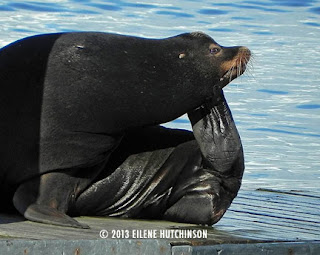California Sea Lion
|
Steller Sea Lion
|
|
Males: 800lbs Females: 250lbs
|
Weight
|
Males: 2200lbs Females: 800lbs
|
Males: 8ft Females: 5ft
|
Length
|
Males: 8-11ft Females:6-7ft
|
Dark brown coat. Females and juveniles may have a lighter coat. Beige or brown whiskers
|
Color
|
Light tan to gold or reddish brown. No markings, pale whiskers.
|
Vancouver Island, BC to Southern tip of Baja California
|
Distribution
|
Steller sea lions are found in coastal waters of the North Pacific Ocean from Japan to central California.
|
California sea lions may hunt continuously for up to 30 hours, with each dive lasting three to five minutes.
|
Fun Fact
|
Steller Sea Lions swallow stones up to 12 cm—and no one knows why!
|

Male California Sea Lion
|
California Sea Lion:
- visible sagital crest
- large, wing like fore flippers
- short hairs all over body
- California Sea Lion Calls (From Macaulay Library at Cornell University)
 |
| Male Steller Sea Lion |
Male Steller Sea Lion:
- blunt face and boxy, bear like head
- no visible sagital crest
- bulky build
- very thick neck
- thick coat of hair on neck
- Steller Sea Lion Calls (From Marine Mammal Center)
In the News:
Researchers are breaking down the science behind how a Sea Lion propels itself in an effort to apply similar mechanics to an underwater robot. After hundreds of hours of video the researchers at George Washington University noticed a distinct propulsion system. "First the animal collects water in its fore flippers, and then quickly scoops the water in toward its body. Then it claps its flippers against its torso, pushing the water toward its rear flippers and propelling it forward in a glide."
also in the news:
The other week, a Sea Lion pup was found sleeping in the booth of a popular seaside restaurant in San Diego! I guess the food was so good, he didn't want to leave.
Did you know:
Sea lions are the first non-human mammal that we know of that has the ability to keep a beat, suggesting that rhythm may be more common in the animal kingdom than we thought.
And remember!!
If you see a stranded marine mammal, call the PTMSC Marine Mammal Hotline
360.585.5582 x 103
—
KATIE CONROY is the Marine Mammal Stranding Educator and an AmeriCorps member serving at the Port Townsend Marine Science Center.


The most amazing shore-side sight for me happened just north of the Hearst Castle in CA - in Feb. It is the time the elephant seals come ashore to birth the young, and to take up with anyone interesting. There were hundreds, if not thousands, as far as the eye could see - north or south!!!
ReplyDeleteWow! that sounds like it was a wonderful experience!
ReplyDeleteThank you, Katie!!! It truly was amazing!!!!
ReplyDeleteFor me it is all about the nose - the Cali Lion is very prominent, the Steller is more turned down.
ReplyDelete